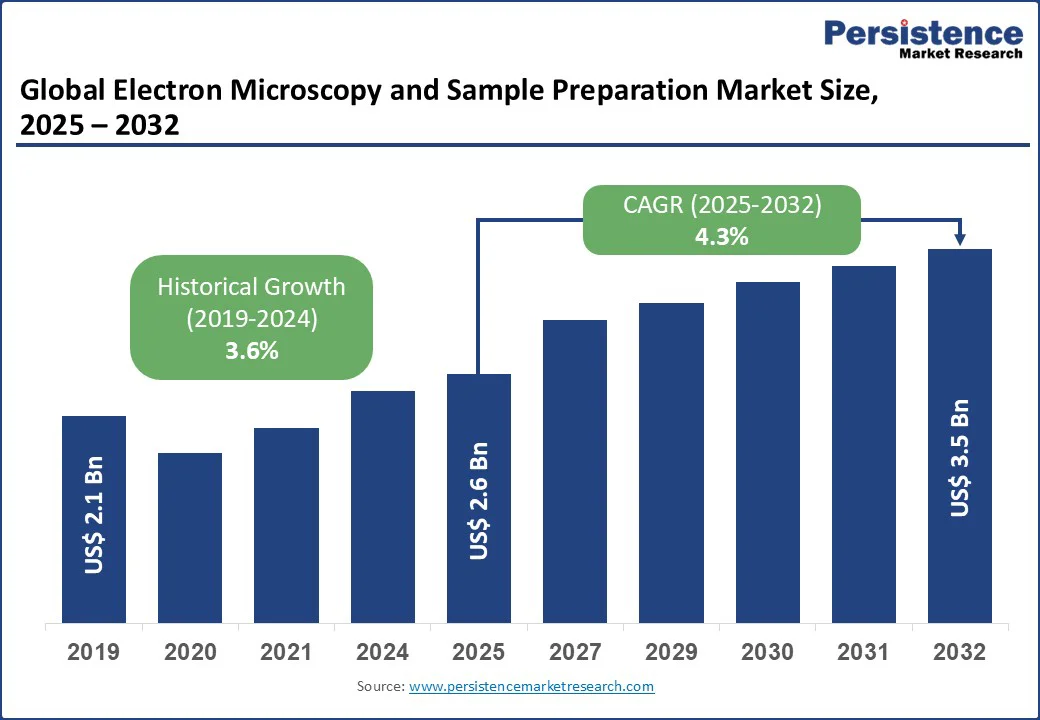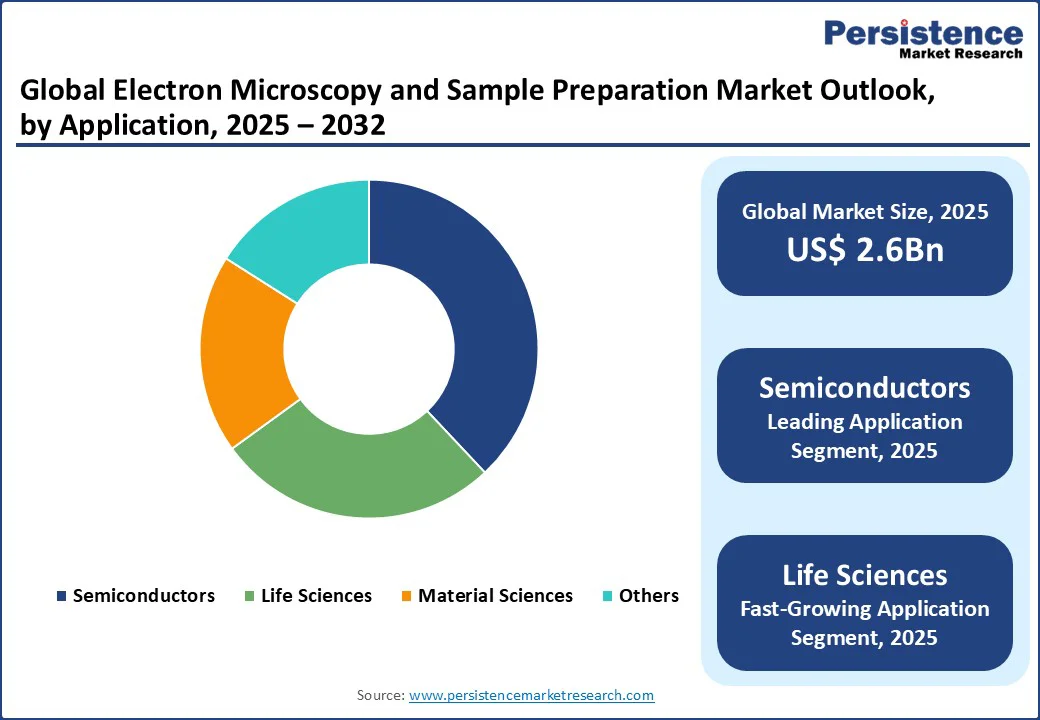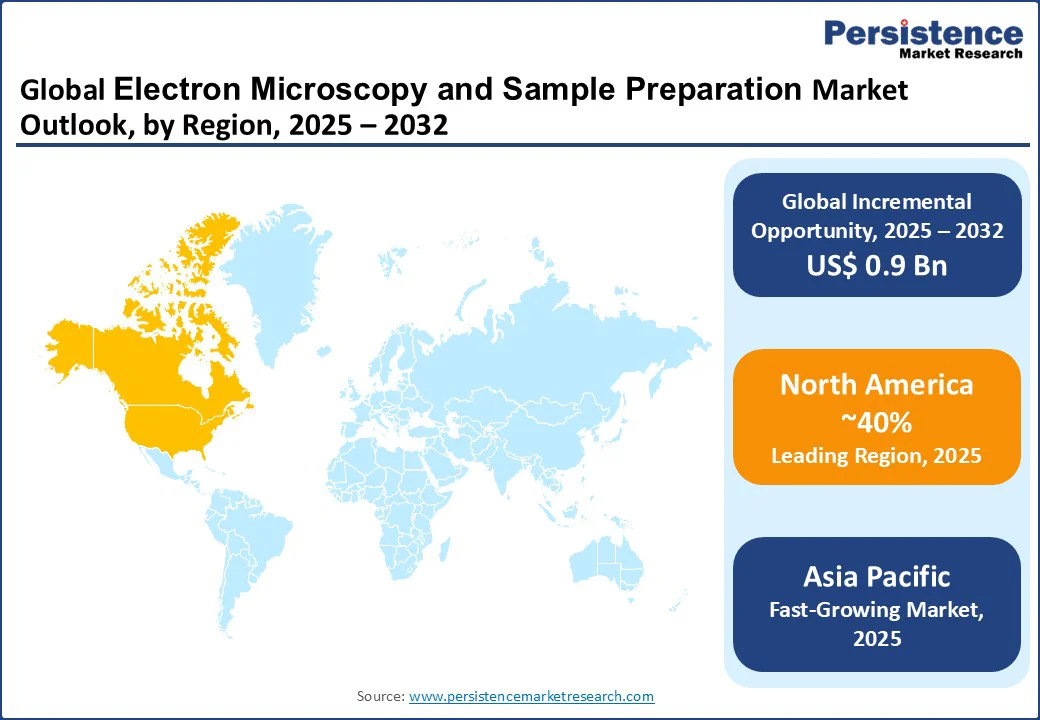ID: PMRREP7490| 187 Pages | 19 Sep 2025 | Format: PDF, Excel, PPT* | Healthcare

The global electron microscopy and sample preparation market size is likely to be valued at US$ 2.6 Bn in 2025 and is expected to reach US$ 3.5 Bn by 2032, growing at a CAGR of 4.3% during the forecast period from 2025 to 2032 driven by the increasing demand for high-resolution imaging and analysis across diverse industries, including semiconductors, life sciences, and material sciences.
Key Industry Highlights:

| Key Insights | Details |
|---|---|
| Electron Microscopy and Sample Preparation Market Size (2025E) | US$2.6 Bn |
| Market Value Forecast (2032F) | US$3.5 Bn |
| Projected Growth (CAGR 2025 to 2032) | 4.3% |
| Historical Market Growth (CAGR 2019 to 2024) | 3.6% |
The increasing adoption of nanotechnology and advanced materials research is playing a pivotal role in driving the growth of the electron microscopy and sample preparation market. Nanotechnology has become an essential discipline across industries ranging from healthcare and electronics to energy and materials engineering.
Its applications require precise visualization and analysis at the atomic and molecular levels, which electron microscopy uniquely enables. As nanomaterials are widely explored for drug delivery systems, diagnostic tools, energy storage devices, and lightweight structural components, the demand for high-resolution imaging and accurate structural characterization continues to expand.
The rapid advancement of advanced materials research is fueling the need for sophisticated microscopy solutions. From composite materials and biomaterials to semiconductor substrates and polymers, scientists and engineers rely heavily on electron microscopy to study surface morphology, particle size, and structural properties.
This enables breakthroughs in developing materials with enhanced strength, conductivity, and efficiency. For instance, in semiconductor research, electron microscopy is used to analyze nanoscale defects in microchips, ensuring higher performance and reliability in consumer electronics.
Furthermore, rising investments from governments and private organizations in research and development initiatives are accelerating innovation in both nanotechnology and advanced materials. Collectively, these factors are significantly boosting the adoption of electron microscopy systems and sample preparation equipment worldwide.
The high costs associated with electron microscopy equipment and maintenance pose a significant restraint on market growth. Electron microscopes are sophisticated instruments that require advanced technology, specialized components, and precision engineering, making them significantly more expensive than conventional optical microscopes.
The upfront investment for acquiring high-resolution transmission electron microscopes (TEMs) or field emission scanning electron microscopes (FEG-SEMs) can run into several million dollars, placing them beyond the reach of many academic institutions, small laboratories, and mid-sized research facilities.
In addition to the initial purchase price, these instruments demand substantial recurring expenditures for maintenance, calibration, and replacement of specialized parts such as electron sources, detectors, and vacuum systems. Regular servicing is critical to ensure accuracy and reliability, but it further increases operational costs.
Moreover, the requirement for controlled environments, including vibration isolation, temperature regulation, and clean room facilities, adds another layer of expense.
For instance, installing a cryo-electron microscope often necessitates infrastructure upgrades, significantly raising total costs. These financial barriers limit adoption, particularly in developing regions, and may slow down the wider penetration of electron microscopy technologies despite their growing scientific importance.
The integration of artificial intelligence (AI) and automation into microscopy workflows is creating a significant opportunity for the electron microscopy and sample preparation market.
Traditional microscopy techniques, while powerful, are often labor-intensive, time-consuming, and reliant on highly skilled operators to prepare samples, capture images, and interpret data. By embedding AI-driven image analysis and automated systems into these workflows, researchers can dramatically enhance efficiency, accuracy, and reproducibility.
AI algorithms can rapidly process large volumes of imaging data, identify nanoscale features, detect defects, and even generate predictive models, reducing the risk of human error and speeding up research timelines.
Automation also simplifies sample preparation, enabling consistent handling and minimizing contamination risks. For instance, automated cryo-electron microscopy platforms can streamline processes such as vitrification and grid loading, allowing researchers to focus more on interpretation rather than repetitive manual tasks.
In industrial applications, particularly in semiconductor and materials science, automated electron microscopy systems can support high-throughput defect analysis and quality control, meeting the demands of mass production. As the volume of data in nanotechnology and life sciences grows, the convergence of AI and automation with electron microscopy is expected to unlock new efficiencies and broaden adoption across both academic and commercial sectors.
Microscopes dominate and are expected to account for a 39% share in 2025. Their dominance stems from their critical role in providing high-resolution imaging for applications across semiconductors, life sciences, and material sciences.
Companies such as Carl Zeiss AG and JEOL Ltd. offer advanced SEMs and TEMs that enable real-time imaging and analysis, making them a preferred choice for industries and research institutes. The modular designs of modern microscopes, which allow integration with advanced software and accessories, further drive their adoption.
The software segment is the fastest-growing, fueled by the increasing integration of AI and automation in microscopy workflows. Software solutions enhance image processing, data analysis, and system integration, enabling faster and more accurate results.
The rise in demand for high-throughput imaging and analysis, particularly in semiconductor and life sciences applications, is accelerating the adoption of advanced software solutions. Companies such as Oxford Instruments and Bruker Corporation are leading the development of AI-integrated software, driving growth in this segment.
Semiconductors lead, accounting for a 38% share in 2025. The critical need for precise imaging and analysis in microchip design, quality control, and failure analysis drives the segment’s dominance.
Electron microscopes are essential for inspecting nanoscale features in semiconductor devices, ensuring high performance and reliability. Companies such as Thermo Fisher Scientific and Hitachi High-Technologies provide specialized microscopy solutions tailored for semiconductor applications, supporting the segment’s growth.
The life sciences segment is the fastest-growing, propelled by the increasing use of electron microscopy in biological research, such as cellular imaging, protein analysis, and drug development. The rise in biotechnology research, particularly in areas such as cancer research and virology, has spurred demand for advanced microscopy and sample preparation techniques.
Industries hold the largest market share, accounting for nearly 53% in 2025. Industrial applications, particularly in semiconductors and material sciences, rely heavily on electron microscopy for quality control, product development, and failure analysis. Companies such as Danaher Corporation and Nikon Corporation provide tailored microscopy solutions for industrial clients, ensuring high precision and reliability.
The academic and research institutes segment is the fastest-growing, driven by increasing government funding for scientific research and the adoption of advanced microscopy technologies in universities and research centers. The growing focus on nanotechnology, biotechnology, and material sciences research is accelerating the adoption of electron microscopy in academic settings, particularly in North America and the Asia Pacific.

North America is projected to account for nearly 40% of the global electron microscopy and sample preparation market, reflecting its leadership in research and technological innovation. The region’s dominance is primarily driven by the presence of major industry players such as Thermo Fisher Scientific, Danaher Corporation, and Bruker Corporation in the United States.
The U.S. market is fueled by robust investments in nanotechnology, biotechnology, and semiconductor research, supported by government agencies such as the National Science Foundation and the National Institutes of Health, which allocate significant funding for scientific research.
The rising demand for high-resolution imaging in semiconductor manufacturing, particularly for advanced microchips used in AI and 5G technologies, is a key driver. Additionally, the U.S. is a hub for academic research, with universities such as MIT and Stanford leading advancements in life sciences and material sciences.
The adoption of AI-integrated microscopy solutions and automated sample preparation systems is further accelerating market growth. With strong private and public investments, North America continues to set global standards in precision, performance, and innovation, making it a frontrunner in shaping the future of the electron microscopy market.
Europe is emerging as a significant player in the electron microscopy and sample preparation market, supported by strong institutional frameworks and collaborative research programs. The European Union’s Horizon Europe program, along with national agencies such as Germany’s DFG and the UK’s Research Councils, is driving substantial investments in scientific research and nanotechnology.
Countries such as Germany, France, and the UK are leading the region’s growth, with companies such as Carl Zeiss AG and Oxford Instruments plc at the forefront of developing advanced microscopy solutions.
The region’s focus on sustainable materials, biotechnology, and semiconductor research is fueling demand for high-resolution microscopy and sample preparation systems. Europe’s emphasis on reducing reliance on external suppliers and developing sovereign technological capabilities is encouraging greater R&D in microscopy technologies.
The growing adoption of electron microscopy in life sciences, particularly for drug development and medical research, further strengthens Europe’s market position, ensuring steady growth in the coming years.
Asia Pacific is emerging as the fastest-growing region, supported by multiple factors that are accelerating adoption and investment. Rapid advancements in semiconductor manufacturing are a key driver, as countries such as China, Japan, South Korea, and Taiwan continue to strengthen their positions as global leaders in electronics production.
The demand for high-resolution imaging tools to ensure quality control and enhance microchip design has significantly boosted the need for electron microscopy in the region.
Alongside, governments across the Asia Pacific are funding for scientific research, particularly in fields such as nanotechnology, materials science, and life sciences, creating a favorable environment for the expansion of advanced microscopy solutions. Academic institutions and research organizations are also playing a central role by integrating electron microscopy into their R&D capabilities.
Moreover, growing collaboration between universities and industry players is fostering innovation and technology adoption. Collectively, these trends position the Asia Pacific as the fastest-growing market, expected to expand at the highest CAGR during the forecast period, outpacing other global regions.

The global electron microscopy and sample preparation market is highly competitive, featuring both multinational leaders and specialized regional players. In North America and Europe, major companies such as Thermo Fisher Scientific, Danaher Corporation, Hitachi High-Technologies Corporation, Carl Zeiss AG, Bruker Corporation, and JEOL Ltd. dominate through their large-scale operations, advanced R&D capabilities, and strong partnerships with research institutions and industries.
In Asia Pacific, rapid growth in semiconductors, material sciences, and life sciences research is attracting substantial investments from global firms such as Nikon Corporation, Olympus Corporation, and Oxford Instruments plc, as well as emerging regional companies.
Market competition is increasingly driven by product innovation, with companies focusing on AI-integrated microscopy, automated sample preparation, and digital imaging solutions to enhance efficiency and precision. Firms are also leveraging strategic collaborations with academic institutes, acquisitions to broaden product portfolios, and digital-first strategies to strengthen global reach.
While established players consolidate leadership positions, niche companies such as Angstrom Advanced Inc., TESCAN Orsay Holding, and Nion Company cater to specialized research applications and cost-sensitive markets, creating a dynamic and fragmented industry landscape.
The global electron microscopy and sample preparation market is projected to reach US$ 2.6 Bn in 2025.
The increasing adoption of nanotechnology and advanced materials research is a key driver.
The electron microscopy and sample preparation market is poised to witness a CAGR of 4.3% from 2025 to 2032.
Advancements in AI and automation in microscopy workflows are a key opportunity.
Thermo Fisher Scientific, Danaher Corporation, Hitachi High-Technologies Corporation, Carl Zeiss AG, and JEOL Ltd. are key players.
| Report Attribute | Details |
|---|---|
| Historical Data/Actuals | 2019 - 2024 |
| Forecast Period | 2025 - 2032 |
| Market Analysis | Value: US$ Bn, Volume: As Applicable |
| Geographical Coverage |
|
| Segmental Coverage |
|
| Competitive Analysis |
|
| Report Highlights |
|
By Product Type
By Application
By End-Use
By Region
Delivery Timelines
For more information on this report and its delivery timelines please get in touch with our sales team.
About Author